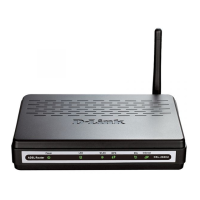Web Configuration
D-Link DSL-2600U User Manual
34
For example, you can define that FTP uses address X to reach computer A and Telnet also uses address X to reach computer A. But attempting to define FTP to use
address X to reach both computer A and B fails. DSL router, therefore, provides the ability to add additional public IP addresses to port forwarding rules, which you must
obtain from your ISP, and enter into the IP addresses pool. Then, you can define FTP to use address X to reach computer A and address Y to reach computer B.
Additionally, port forwarding enables you to redirect traffic to a different port instead of the one to which it was designated. For example, if you have a Web server running
on your PC on port 8080 and you want to grant access to this server to any one who accesses DSL router via HTTP.
To accomplish this, do as follows:
Step 1 Define a port forwarding rule for the HTTP service, with the PC IP or host name.
Step 2 Specify 8080 in the Forward to Port field.
All incoming HTTP traffic is forwarded to the PC running the Web server on port 8080. When setting a port forwarding service, ensure that the port is not used by another
application, which may stop functioning. A common example is when using SIP signaling in Voice over IP, the port used by the gateway VoIP application (5060) is the same
port, on which port forwarding is set for LAN SIP agents.
Note: Some applications, such as FTP, TFTP, PPTP and H323, require the support of special specific application level gateway (ALG) modules in order to work inside the
home network. Data packets associated with these applications contain information that allows them to be routed correctly. An ALG is needed to handle these
packets and ensure that they reach their intended destinations. DSL router is equipped with a robust list of ALG modules in order to enable maximum functionality in
the home network. The ALG is automatically assigned based on the destination port.
Virtual servers are configured for this purpose.
Adding Port Forwarding
Step 1 To set up virtual servers for a service, select Advanced Setup > NAT > Virtual
Servers, and click Add.

